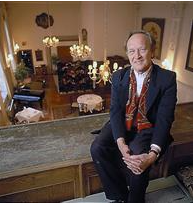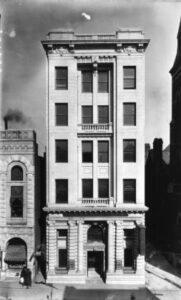A little over 30 years ago I walked through the doors of a stately old building on Gay Street and entered a restaurant I didn’t know existed. I was meeting Knoxville’s grandfather of historic preservation, Kristopher Kendrick, for lunch. The reason for our meeting was a story I was working on about the revived and thriving Old City.
Kendrick was the grand instigator of that particular urban rebirth, still in its first decade of renaissance. I did not know it at the time, but in late July of 1991, I had entered the last six months of The Knoxville Journal’s existence, and phase one of my fledgling reporting career was soon to end.

Kristopher Kendrick in the library overlooking the dining room of the Old City Club, 1994 (Photo credit: KNS archives)
The place in question was The Old City Club, on the same block as the Tennessee Theatre, diagonally across the street from the East Tennessee History Center. Built in 1907, the building still bears the name of its original owner, the Mechanics Bank and Trust Company. It later housed the Union National Bank, a branch of Hamilton National Bank and by the early 1980s was the home of City and County Bank, part of the debacle of the Butcher family banking empire.
The original City Club (not owned by Kendrick) sat at Clinch Avenue and Walnut Street in 1980. It and several other buildings met the wrecking ball to make way for the Knoxville Hilton. In the aftermath, Kendrick opened the Old City Club in the Mechanics building at 612 S. Gay Street in 1984. Food service in the club took an upward swing in 1985 after his Kristoffer and Company Headquarters along with his four-star restaurant, The Orangery, went up in flames. The whole operation moved into the club the same day and served dinner as The Orangery that night.
A primary reason I had never heard of the place was that it was, indeed, a private club. The dining area occupied the first floor of the building, with a library on the mezzanine overlooking from above. The old bank vault was used for a bar and wine cellar.

Mechanics Bank and Trust Building (Photo Credit KNS digital archives)
It was classic and elegant, much like the man who sat across the white tablecloth from me in a Chippendale style chair and regaled me with stories from his long list of restoration adventures in Knoxville. I don’t remember what I ate that day, only that the food and service were impeccable.
I contrast that very buttoned up experience at the Old City Club with that of one of my favorite haunts from the mid-1980s, The Lord Lindsey. Lindsey’s was one of Kendrick’s earliest efforts in historical salvage. Just three blocks south on Gay then three blocks west on Hill Avenue, the antebellum-styled house sits on a rise overlooking the Tennessee River.
Built in 1900 as a residence for the Percy Lockett family, the space was later converted to a house of worship and operated as the First Church of Christ Scientist for 50 years. By 1977, Kendrick had converted the site to a bar, restaurant and event space. But Thursday through Saturday nights it was THE place in Knoxville to shake your groove thing. The place was legendary (what happens at Lord Lindsey’s stays at Lord Lindsey’s). There was nothing like it before, and there’s been nothing like it since. And for the record, Knoxville had an old church converted to a disco four years before New York City had the Limelight. It was a barrel of fun, and, yes, you had to be there.
The Lord Lindsey has sat idle for the better part of two decades and holds a place on Knox Heritage’s “fading fast” list. Back in 1991, I asked Kendrick if the Old City then was what he had in mind all along. He answered, “in a word, yes, it has met my expectations, and I expect them to be exceeded … You’re not going to find the Old City in a mall.”
Kendrick died in 2009, but his legacy is stamped all over Knoxville’s downtown revival. Overall, I think he would be quite pleased. It would be a shame if the grand old dame that was the party palace in his portfolio became just a footnote in history.
Beth Kinnane writes a history feature for KnoxTNToday.com. It’s published each Tuesday and is one of our best-read features.
Sources: The Knoxville Journal and Knoxville News-Sentinel Digital archives

